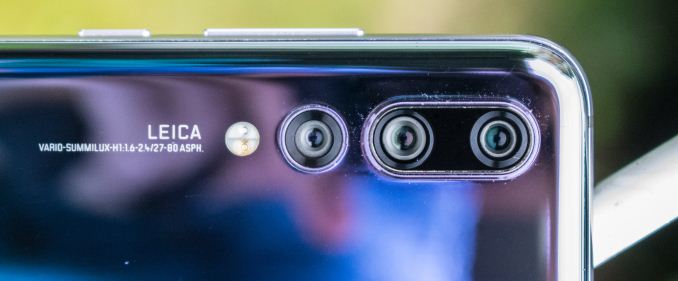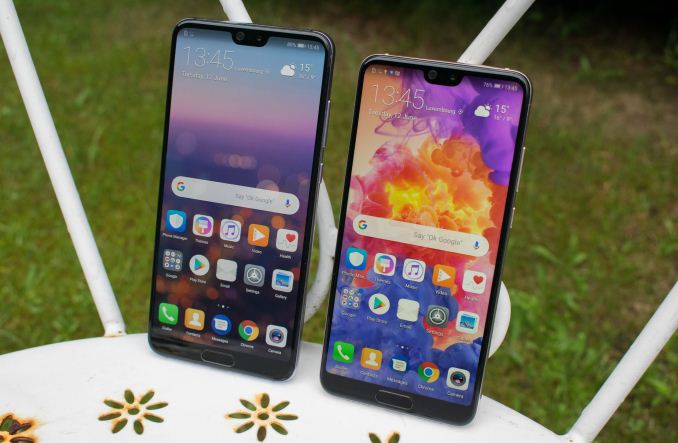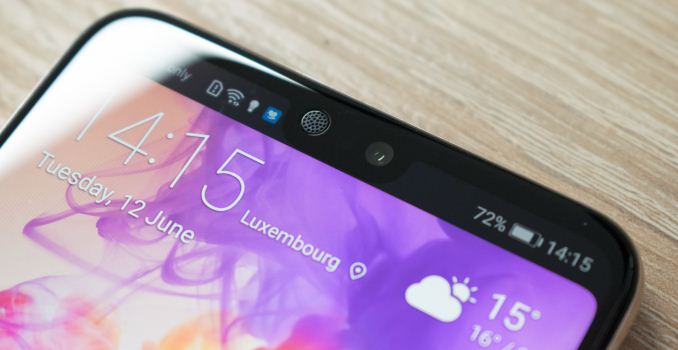The Huawei P20 & P20 Pro Review: Great Battery Life & Even Better Night Vision
by Andrei Frumusanu on June 15, 2018 11:00 AM ESTConclusion & End Remarks
The Huawei P20 and P20 Pro are hard to judge in terms of overall devices. Compared to last year’s P10 series, we see upgrades across the board in terms of design, performance, battery and camera. But what matters is the comparison to the competing devices as well, and there things are a little less evident.
Design-wise, the P20 and P20 Pro bring a large overhaul in Huawei’s design language and have very little in common with last year’s P10. Both phones have jumped on board the glass back design and it’s evident that Huawei tried to take some design cues from Apple’s iPhone X – with a similar camera layout and design as well as a trendy notch.
In my experience, the ergonomics of both new devices were very good and I think that’s also largely due to Huawei keeping the thickness to a minimal level. In terms of industrial design the only gripe I had with the phones were the glossy side-bezels that just didn’t really feel very premium – an issue that seems to be limited to the colour variation of the units I have as the black variant seems to opt for a matte finish instead.
As I did praise Samsung in the Galaxy S9 review for keeping it, I have to call out Huawei on removing the headphone jack on the P20’s. While this may be a little late now and I doubt we’ll see a return in the future (one can hope), it seems that I have to purposefully mention this in reviews so that other manufacturers avoid doing the same move in the future.
The screens of the P20 and P20 Pro are definitely experience defining as Huawei did a good job in designing a device with a notch without any of the negative side-effects. Applications work seamlessly with the notch and it never comes in the way in landscape views. In portrait mode, the notch is easily hidden by blacking it out and effectively it serves its original purpose: increasing the usable screen estate of the phones.
The P20’s LCD screen was the least impressive feature as I did not see any of the power efficiency advantages of the new RGBW layout while it provided an effective resolution and sharpness reduction compared to traditional RGB LCDs. The lacking default calibration settings also a negative point- however at least that can be remedied through individual adjustments by the user.
The P20 Pro screen fared a lot better, providing extremely accurate experience in sRGB mode, although DCI-P3 mode veered off too much in its blue saturations. Power efficiency was also in the norm – so the only negative here is I think Huawei could have gone with a 1440p display finally, given the increased size of the phone as well as the fact that it’s an AMOLED panel with less resolution power penalties.
Performance of the P20’s is very good and in everyday usage I found no issues with the phones. It’s to be noted that Snapdragon 845 devices offer a faster experience in everyday usage, so in that regard using last year’s CPU cores doesn’t fell that well for the Kirin 970. The biggest disadvantage is in the GPU performance where the P20 are just absolutely lacklustre due to the fact that the chipset uses a smaller configuration Mali GPU, and what seems to be that Huawei is running the P20 firmware and the SoC’s memory controller at a reduced speed.
What is lacking in performance is however more than made up in battery life. The P20 Pro is the longest lasting flagship device we ever tested and is a showcase of what happens when you combine a larger battery with an efficient screen and efficient SoC. The smaller P20, while not posting quite the impressive battery figures of the P20 Pro, still enjoys excellent battery life and outperforms the competition within its class.
The camera is by far the P20 Pro’s signature feature, so it may come as a surprise that I have my reservations about it. Huawei’s main issues here is that the camera experience in terms of shooting modes and getting the best result out of a given scene is very convoluted. The 40MP shooting mode is a separate resolution mode in the settings that has to be toggled on that disables the secondary zoom camera – something which generally doesn’t make sense to me. This, along with the fact that the 10MP mode is the default one enabled with the camera, makes me question just how usable the 40MP mode is in every day scenarios.
When comparing the 40MP captures – the P20 Pro does have notable advantage in terms of details. In 10MP mode, I would give it to competing devices such as the Galaxy S9 which is still king in terms of detail. Exposure in difficult situations also wasn’t quite up to par with Apple and Samsung so there’s definitely improvements to be one on Huawei’s camera calibration. The AI feature on the P20’s were also more detrimental than beneficial in terms of resulting photo quality – I think the camera could have largely done without it – luckily one can disable it.
The telephoto lens on the P20 Pro is what actually impressed me the most – its quality was generally superb and for the zoom factor that it gives it’s just a tier above all other optic 2x solutions currently found in other devices. What I think is the defining difference between the telephoto camera and the main camera is the fact that it’s the only one which actually includes OIS. The lack of OIS in general is I think what keeps the P20 Pro and P20 from really shining in terms of daylight picture quality – as overall now given both factors of exposure and detail retention, I prefer the Galaxy S9 or the V30. Video capture also suffers very badly from the lack of OIS, as Huawei’s EIS only works in 1080p30 mode and just doesn’t offer the same sharpness that a real OIS camera does.

In night time shots, the P20 Pro is a lot less controversial. First of all, the 40MP mode can just be ignored in low-light scenarios as it just doesn’t cut it. The pixel binning of four physical pixels into one logical pixels when using the 10MP is however what gives the P20 Pro an outstanding low light capture advantage. Again, in some scenes it maybe doesn’t quite match the S9’s detail retention, however it makes up for it with a very large dynamic range advantage that just creates much better low-light shots.
This is also the first phone camera that deserves to be in a category of its own: extreme low-light photography. Here the P20 Pro shines with its camera sensor that’s able to go to extremely high ISO values – but the P20 as well is able to provide some very impressive shots thanks to the Night mode which is essentially a new paradigm when it comes to computational photography.
So is the P20 Pro or P20 worth consideration? In Germany the P20 Pro and P20 can be found respectively at 730€ and 520€ while in the UK it’s still listed at near the launch prices of of £700-830 and £549. The direct competition here is obviously the S9+ and S9 – but there’s also now options such as the LG G7. I do think Huawei is recently pricings its flagships a tad too high, because they do have shortcomings that you would not want a device of that price-range to have.
Overall I think it’s going to be a very subjective decision based on what the buyer wants to prioritise, especially when it comes to battery life and camera experience. If you value battery life over everything else, then the P20’s are your go-to choice in terms of current flagships. If you value more performance and in particular gaming, you might be better served by a Snapdragon 845 device such as the G7, or have a look at last year’s G6 or V30. To be honest, this is a hard conclusion for me to write because the P20’s are such polarising devices having both some extremely good positives but also some few negatives. Best is, you go through the results yourself and build your own opinion!












81 Comments
View All Comments
Vishnu NS - Friday, June 15, 2018 - link
Andrei - I have the Mate 9 and I get regular monthly security updates. I just got my June 2018 update yesterday. Cheers! Love the review, strongly eyeing the Mate 10 Pro at $549 on Amazon currently. Also awaiting the Pixel 3 XL release later this year before making a new purchase.Regards,
Vish
chocolatine - Wednesday, June 27, 2018 - link
My P10+ (in France) has the may 2018 security patches (and Android 8). Using the HiSuite software updater while your phone is plugged in your computer works much better than using the system update menu of the phoneamouses - Friday, June 15, 2018 - link
The Mate10 is supported by Project Treble. And so swifter updates are possible. But so such assurance has been given for any P20 variant. I've repeatedly asked Huawei via official and unofficial forums. You will also notice that Huawei was absent from the Android P Beta programme. Not a good sign.eastcoast_pete - Friday, June 15, 2018 - link
Thanks Andrei! While some other commentators here seem to have had luck getting updates for their Huawei phones, my experience mirrors yours - spotty or no updates. Would love to hear that they are fully committed to timely updates and longer-term support for their phones.sonicmerlin - Sunday, June 17, 2018 - link
Don't these come with Project Treble? Shouldn't that make updating far easier?mmrezaie - Sunday, June 17, 2018 - link
It doesn't on my Motorola! It is still on Android 8.0 and security update from Feb. I think I have got only three updates since it got introduced as one of the first Project Terrible phones. Pun intended.Round - Tuesday, June 26, 2018 - link
I'm sure Huawei will release updates as soon as they get an approved version from the communist government or the PLA, that has improved tracking apps built in at the OS level. You can trust these guys, along with their friends at ZTE, another stalwart of honesty and integrity.Lodix - Friday, June 15, 2018 - link
Nice review.I noticed the Xiaomi Mi Mix2s has the same problems in terms of GPU throttling as the S9+. Do you know what is causing this behaviour?
Andrei Frumusanu - Friday, June 15, 2018 - link
It's just the behaviour of S845 devices it seems - the MIX 2S review will be a separate piece after this.ZolaIII - Friday, June 15, 2018 - link
Probably the step into right direction. Xiaomi uses CAF defaults this day's & yes they are very aggressive.To answer the question;
The A75's are about 50% larger more power hungry compared to the A73's both SoC's are made on the 10 nm Samsung FinFET while later one (S845) is made on more optimised one which is let's say capable of saving around 20% power compared to the early one. The S845 is also clocked hire and all do it's only 12~13% those eat additional 25~30% more power. The all FinFET structures leak insanely when the around 2.1~2.2GHz limit is crossed so more than that should be used for short bursts and only when really needed. In the end we have 1.5~1.6x CPU power consumption while sustainable power limit remains the same 2.5~2.7W. This is enough to diminish the A630 efficiency/performance/proces advantages of around 30% combined. Their is no hotpluging in user space whatsoever on any newer Snapdragon SoC's/builds (since removing the Core_ctl a year ago) which can help a lot regarding sustainable GPU performance. At the end it's at least easy to play with Kirin regarding limiting the CPU frequency scheduling as it uses good old interactive governor & I am certain it will be very beneficial regarding GPU through.
Best regards.